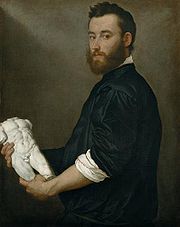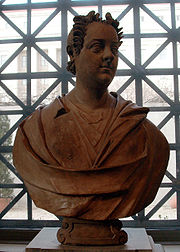
Alessandro Vittoria
Encyclopedia

Italy
Italy , officially the Italian Republic languages]] under the European Charter for Regional or Minority Languages. In each of these, Italy's official name is as follows:;;;;;;;;), is a unitary parliamentary republic in South-Central Europe. To the north it borders France, Switzerland, Austria and...
Mannerist
Mannerism
Mannerism is a period of European art that emerged from the later years of the Italian High Renaissance around 1520. It lasted until about 1580 in Italy, when a more Baroque style began to replace it, but Northern Mannerism continued into the early 17th century throughout much of Europe...
sculptor
Sculpture
Sculpture is three-dimensional artwork created by shaping or combining hard materials—typically stone such as marble—or metal, glass, or wood. Softer materials can also be used, such as clay, textiles, plastics, polymers and softer metals...
of the Venetian school
Venetian school (art)
-Context:In the 15th century Venetian painting developed through influences from the Paduan School and Antonello da Messina, who introduced the oil painting technique of Early Netherlandish painting. It is typified by a warm colour scale and a picturesque use of colour...
, "one of the main representatives of the Venetian classical style" and rivalling Giambologna
Giambologna
Giambologna, born as Jean Boulogne, incorrectly known as Giovanni da Bologna and Giovanni Bologna , was a sculptor, known for his marble and bronze statuary in a late Renaissance or Mannerist style.- Biography :...
as the foremost sculptors of the late 16th century in Italy.
Vittoria was born in the Italian city of Trent and was the son of a tailor. Vittoria was trained in the atelier of the architect-sculptor Jacopo Sansovino
Jacopo Sansovino
Jacopo d'Antonio Sansovino was an Italian sculptor and architect, known best for his works around the Piazza San Marco in Venice. Andrea Palladio, in the Preface to his Quattro Libri was of the opinion that Sansovino's Biblioteca Marciana was the best building erected since Antiquity...
; he was a contemporary of Titian
Titian
Tiziano Vecelli or Tiziano Vecellio Tiziano Vecelli or Tiziano Vecellio Tiziano Vecelli or Tiziano Vecellio (c. 1488/1490 – 27 August 1576 better known as Titian was an Italian painter, the most important member of the 16th-century Venetian school. He was born in Pieve di Cadore, near...
whose influence can be detected in his compositions. He was a virtuoso in terracotta, often presented with gilded surfaces, marble and bronze. Like all Italian sculptors of his generation, Vittoria was influenced also by Michelangelo
Michelangelo
Michelangelo di Lodovico Buonarroti Simoni , commonly known as Michelangelo, was an Italian Renaissance painter, sculptor, architect, poet, and engineer who exerted an unparalleled influence on the development of Western art...
and by the Florentine Mannerist, Bartolomeo Ammanati
Bartolomeo Ammanati
Bartolomeo Ammannati was an Italian architect and sculptor, born at Settignano, near Florence. He studied under Baccio Bandinelli and Jacopo Sansovino and closely imitated the style of Michelangelo.He was more distinguished in architecture than in sculpture...
. The closeness of his associations in projects by architects Sansovino
Sansovino
Sansovino may be*Andrea Sansovino, artist*Francesco Sansovino, scholar*Jacopo Sansovino, sculptor and architectSee also:*A.C. Sansovino football club, a LSI in service during 1945*Sansovino , winner of the 1924 Epsom Derby...
, Sanmicheli and Palladio
Andrea Palladio
Andrea Palladio was an architect active in the Republic of Venice. Palladio, influenced by Roman and Greek architecture, primarily by Vitruvius, is widely considered the most influential individual in the history of Western architecture...
, working with painters Titian
Titian
Tiziano Vecelli or Tiziano Vecellio Tiziano Vecelli or Tiziano Vecellio Tiziano Vecelli or Tiziano Vecellio (c. 1488/1490 – 27 August 1576 better known as Titian was an Italian painter, the most important member of the 16th-century Venetian school. He was born in Pieve di Cadore, near...
, Tintoretto
Tintoretto
Tintoretto , real name Jacopo Comin, was a Venetian painter and a notable exponent of the Renaissance school. For his phenomenal energy in painting he was termed Il Furioso...
and Veronese
Paolo Veronese
Paolo Veronese was an Italian painter of the Renaissance in Venice, famous for paintings such as The Wedding at Cana and The Feast in the House of Levi...
placed him squarely among the protagonists of the Cinquecento art world in late 16th-century Venice.

Trento
Trento is an Italian city located in the Adige River valley in Trentino-Alto Adige/Südtirol. It is the capital of Trentino...
, then moved to Venice, where his long artistic relationship with Sansovino was a stormy one. After one quarrel with Sansovino, he removed from Venice and worked in Vicenza
Vicenza
Vicenza , a city in north-eastern Italy, is the capital of the eponymous province in the Veneto region, at the northern base of the Monte Berico, straddling the Bacchiglione...
, where he collaborated with Veronese on the decorations of the Villa Barbaro at Maser
Villa Barbaro
Villa Barbaro, also known as the Villa di Maser, is a large villa at Maser in the Veneto region of northern Italy. It was designed and built by the Italian architect Andrea Palladio, with frescos by Paolo Veronese and sculptures by Alessandro Vittoria for Daniele Barbaro, Patriarch of Aquileia...
(1560–62) before returning. The two masters worked jointly on great sculptural commissions until Sansovino's death. Vittoria took up his studio and completed Sansovino's unfinished commissions. One of his pupils was Camillo Mariani
Camillo Mariani
Camillo Mariani was an Italian sculptor of the early Baroque.He was born in Vicenza. He apprenticed in the studio of the prominent Venetian Mannerist sculptor Alessandro Vittoria, but moved to Rome in 1597. His first works in Rome were stucco statuary for the churches of San Bernardo alle Terme ...
.
He died at Venice in 1608. His tomb, with his self-portrait bust, is in the church of San Zaccaria.
Vittoria is known for his classicising portrait busts, a genre that scarcely existed in Venice before him, and for medals as well as for his full-length figures, some of which surmount Sansovino's Biblioteca Marciana
Biblioteca Marciana
The Biblioteca Nazionale Marciana is a library and Renaissance building in Venice, northern Italy; it is one of the earliest surviving public manuscript depositories in the country, holding one of the greatest classical texts collections in the world. The library is named after St. Mark, the...
.
Sources
His diary is an important source for the details of his career, as is his will, of 29 July 1576. An exhibition at Trento, 1999 is memorialised in a catalogue by Andrea Bacchi, Lia Camerlengo and Manfred Leithe-Jasper, "La Bellissima Maniera": Alessandro Vittoria e la Scultura Veneta del Cinquecento (Trento 1999) which is the basic text for its introductory essays on Vittoria's art and career, by Manfred Leithe-Jasper; his patrons, by Thomas Martin; his connections with Venetian painting, by Stefano Tumidei; and Vittoria's role as a collector, by Victoria Avery.External links
- J. Paul Getty Museum: vita
- Web Gallery of Art Biography
- http://www.metmuseum.org/Works_Of_Art/viewOne.asp?dep=11&viewMode=1&item=46.31 Portrait of the artist by Paolo VeronesePaolo VeronesePaolo Veronese was an Italian painter of the Renaissance in Venice, famous for paintings such as The Wedding at Cana and The Feast in the House of Levi...
.] - http://www.artic.edu/artaccess/AA_RenBar/pages/REN_6.shtml Relief of Annunciation at Art Institute of ChicagoArt Institute of ChicagoThe School of the Art Institute of Chicago is one of America's largest accredited independent schools of art and design, located in the Loop in Chicago, Illinois. It is associated with the museum of the same name, and "The Art Institute of Chicago" or "Chicago Art Institute" often refers to either...
]

